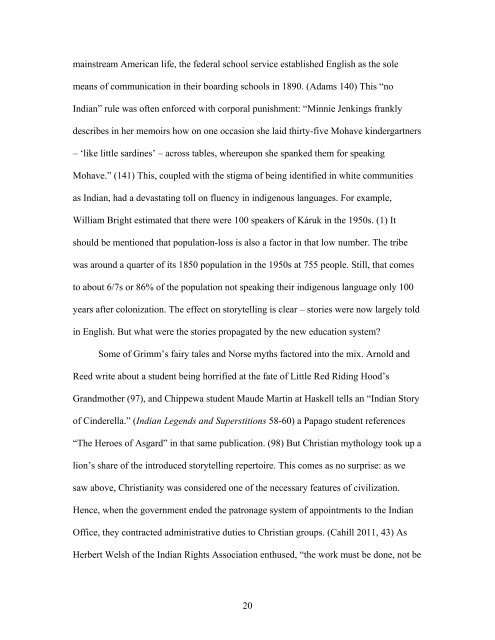The Intersection of Karuk Storytelling and Education
The Intersection of Karuk Storytelling and Education
The Intersection of Karuk Storytelling and Education
You also want an ePaper? Increase the reach of your titles
YUMPU automatically turns print PDFs into web optimized ePapers that Google loves.
mainstream American life, the federal school service established English as the sole<br />
means <strong>of</strong> communication in their boarding schools in 1890. (Adams 140) This “no<br />
Indian” rule was <strong>of</strong>ten enforced with corporal punishment: “Minnie Jenkings frankly<br />
describes in her memoirs how on one occasion she laid thirty-five Mohave kindergartners<br />
– ‘like little sardines’ – across tables, whereupon she spanked them for speaking<br />
Mohave.” (141) This, coupled with the stigma <strong>of</strong> being identified in white communities<br />
as Indian, had a devastating toll on fluency in indigenous languages. For example,<br />
William Bright estimated that there were 100 speakers <strong>of</strong> Káruk in the 1950s. (1) It<br />
should be mentioned that population-loss is also a factor in that low number. <strong>The</strong> tribe<br />
was around a quarter <strong>of</strong> its 1850 population in the 1950s at 755 people. Still, that comes<br />
to about 6/7s or 86% <strong>of</strong> the population not speaking their indigenous language only 100<br />
years after colonization. <strong>The</strong> effect on storytelling is clear – stories were now largely told<br />
in English. But what were the stories propagated by the new education system?<br />
Some <strong>of</strong> Grimm’s fairy tales <strong>and</strong> Norse myths factored into the mix. Arnold <strong>and</strong><br />
Reed write about a student being horrified at the fate <strong>of</strong> Little Red Riding Hood’s<br />
Gr<strong>and</strong>mother (97), <strong>and</strong> Chippewa student Maude Martin at Haskell tells an “Indian Story<br />
<strong>of</strong> Cinderella.” (Indian Legends <strong>and</strong> Superstitions 58-60) a Papago student references<br />
“<strong>The</strong> Heroes <strong>of</strong> Asgard” in that same publication. (98) But Christian mythology took up a<br />
lion’s share <strong>of</strong> the introduced storytelling repertoire. This comes as no surprise: as we<br />
saw above, Christianity was considered one <strong>of</strong> the necessary features <strong>of</strong> civilization.<br />
Hence, when the government ended the patronage system <strong>of</strong> appointments to the Indian<br />
Office, they contracted administrative duties to Christian groups. (Cahill 2011, 43) As<br />
Herbert Welsh <strong>of</strong> the Indian Rights Association enthused, “the work must be done, not be<br />
20
















